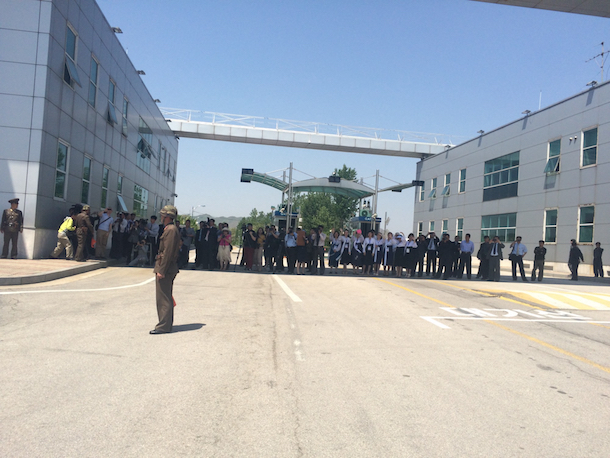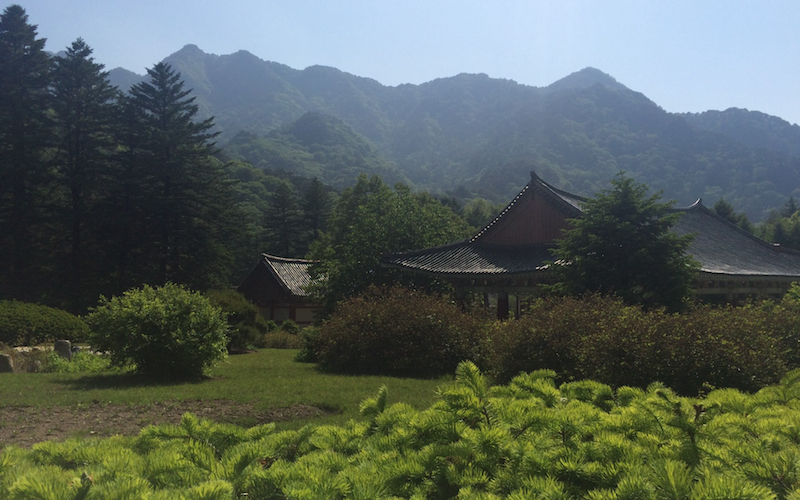
I, Plural: North Korea, a Divided Land of Contradictions
I hold my face in my hands. A long, strange sound comes from me. I’m embarrassed. We’re out in the open; there’s no place to retreat to. I lag behind and stay close to a low stone wall.
I’m in North Korea, two hours from its capital by car, at an ancient Buddhist temple dating back to the 11th century.
On the way there, one of the young minders playfully takes ahold of the bus’s microphone and begins to lead us in song. Everyone knows Arirang, a folk ballad that precedes the war. It is the same for all of us, above and below the 38th parallel.
The bus ride is respite from politics and formality, so everyone is playful and at ease. We make jokes, laugh, sing. Outside the bus window, the quiet countryside passes.
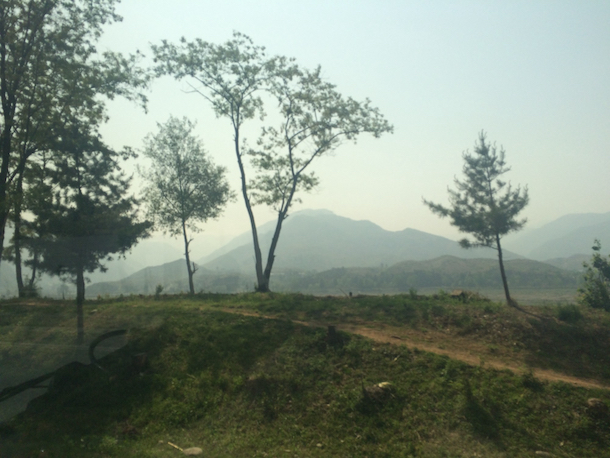
***
When we finally arrive, I’m struck by the calm of the place. How green, pleasant, lovely. A woman in traditional Korean garb and a microphone comes toward us balancing a parasol. She greets us, then leads us on a tour of the extensive grounds.
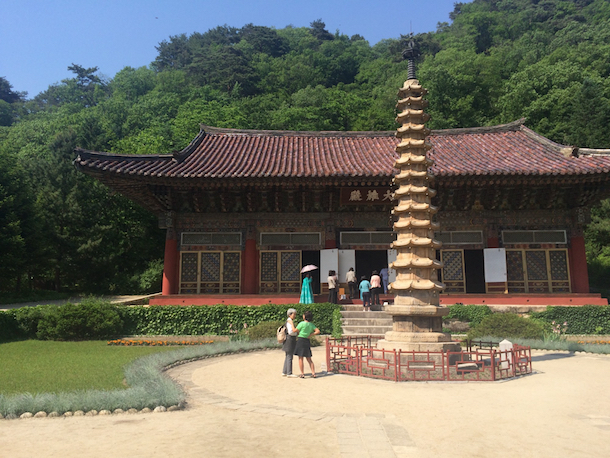
I slowly bring up the rear of our loose ensemble, the 40 or so of us meandering through the sleepy afternoon in quiet chatter. I feel vaguely uneasy.
It’s been a difficult few days; the North Korean government has filled our schedule from early morning until evening, and we were doing a delicate dance of diplomatic etiquette. We wanted to be gracious but we weren’t there to be tourists.
A routine comes into place fairly quickly despite these tensions; we get up early to correspond with CNN, strategize at breakfast, shuttle between sites, performances, and meetings during the day. We find snatches of time to regroup and plan, sometimes composing press releases in transit.
We mainly do our planning late into the night at the hotel after dinner. It’s our only uninterrupted swath of free time. Then we stumble off to bed for two to three hours of fitful sleep, in rooms that are almost certainly bugged. Next to my bed there is something that looks like an old radio, but it does not turn on or off. It is not a radio. Once, at dawn, there is a flash of light from the mirror above the set of drawers.
***
We’re walking the sprawling grounds of Pohyonsa Temple. It’s nestled into Myohyang Mountain, a designated UNESCO biosphere reserve.
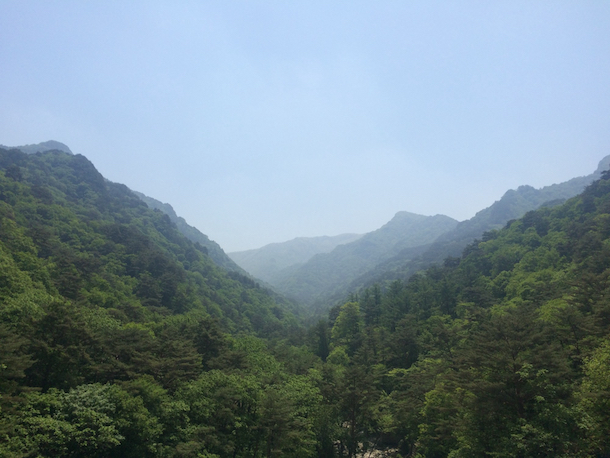
It’s warm and windless. A golden hour. The heat is genial, lulling. I can hear birds, insects. The air breathes pure. I think to myself how beautiful my father would find this place, how my mother and sisters would enjoy being here. Then I think: the way back is closed. I may never see this place again. Cocooned by the afternoon warmth and pacific green, I remind myself that I’m still in a war zone.
War is everywhere. In the faces of the people, in the walls, in the torpid passage of time.
North Korea, alien and frightening, is still my home. I’ve never thought of it this way before.
The injustice of a barred return to my own homeland suddenly blinds me. The recognition of this contrast — the sanguine beauty of the temple set against a reality wrought by outsiders and regimes, by men and war — hits me hard.
All of the sleepless nights, the fatigue, the effort needed to navigate a constant onslaught of new situations, the gravity of why we are here, inundate me and I’m exhausted. Angry. I begin to cry. It’s a release. I flow out of myself and I feel loose, as if in a dream.
It is Friday, May 22nd, 2015.
***
I’m in North Korea on a peace mission, to call for an end to the Korean War.
Thirty of us are core delegates, influential women and veteran activists. Among them are Gloria Steinem and Nobel Peace Laureates Leymah Gbowee (2011), Mairead Maguire (1976).
The peace makers hail from countries all around the world, including Korea, Japan, Liberia, Sweden, Denmark, and the USA. There’s a small but exceptional film crew, a journalist from the Associated Press, a photo journalist on assignment from the New York Times. And me.
My presence here feels accidental; I’m no activist. Christine, the organizer, needed help putting together a brand and an online presence. She happened to know me and I happened to be a designer. My responsibilities grew over time and by the end, I was traveling with the delegation, helping with digital security, managing communications with the press and the public. Still, I’m an unlikely associate. I feel small among giants, a consumer among lifetime survivors who’ve given their lives to causes greater than themselves.
On the 19th of May, 2015, we arrive in Pyongyang. We’re housed in Yanggakdo International Hotel, in the middle of the city.
It is literally surrounded by a moat. Power goes out often and unpredictably. I avoid the elevator and use the stairs several times a day. There are times when I ascend to my room on the thirty-eighth floor, only to realize that I’ve forgotten something on the first.
Only a handful of us — Gloria, the journalists, Christine, me — have access to SIM cards and spotty cellular connections. There is no way to text anyone reliably; I have to descend to retrieve whatever I’ve forgotten, myself.
Technology is both boon and burden; only one day into the stay a critical accessory is misplaced and I can no longer use my laptop to connect via Ethernet. It severely cripples my ability to work.
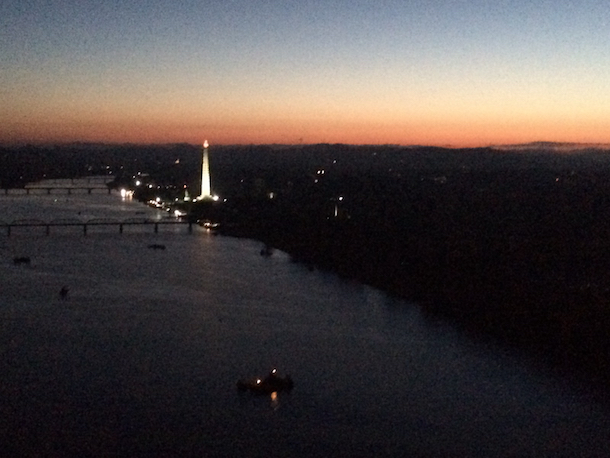
Tensions are high, and rise among us, too. The delegates are divided when it comes to the importance of symbolism versus strategy. Two days before we are to cross, South Korea refuses to give us permission to cross at the iconic Panmunjom. They are explicit.
North Korea in turn informs us that they cannot guarantee our safety if we flout this prohibition.
So we have to choose, and we have to choose together.
Leymah says: “we didn’t come here to die. But if we decide to cross there, keep your hands at your sides. No speaking. No singing. Follow the lead and keep your eyes down.”
Someone says: “they will not shoot. It would be a diplomatic nightmare.”
Someone else: “still, there could be an ‘accident.’ We must be prepared.”
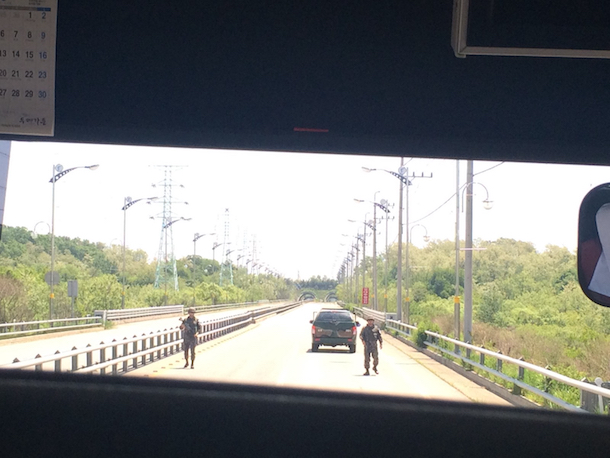
***
I grew up knowing very little about Korea north of the border. My parents clicked their tongues when the goose step appeared on the news with faces that looked like mine. North Koreans were the enemy. They were the Other. They were not us. Commies.
Back then it didn’t occur to me to be interested; to be engaged. They had nothing to do with me.
But I now know that the people are not the regime.
They are my family. They are me. I am them.
***

Thousands of families remain separated by the Korean War. There are occasional state-sanctioned reunions organized by the Red Cross. As of 2015, nearly half of the 130,410 South Koreans who have applied to attend a reunion have died.
It’s painful to watch footage of kin speaking and touching for the first time in decades, to be separated again only after a handful of hours. The simplicity and pedestrian nature of the questions are stark against their weight: “how is Mother? How is your health?”
The answers, just as surreal and brutal: “Mother died two years ago. I am fine.”
It’s difficult to take in. But this is reality. This is what war is. It is baffling.
Why?
Why.
An armistice was signed in 1953, but a peace treaty — promised within 3 months — never materialized, and the country remains divided.
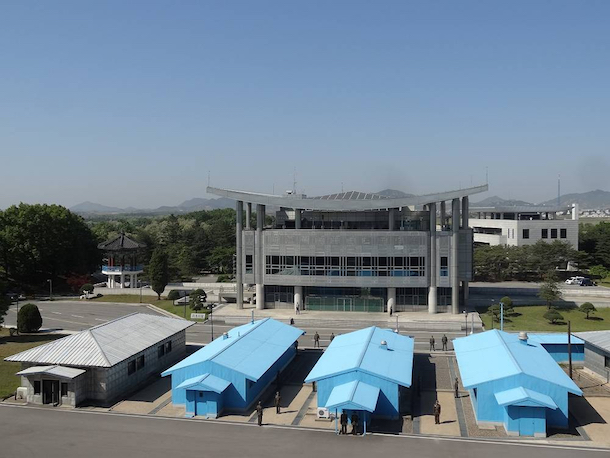
The demilitarized zone that separates the North and South in Korea is ironically one of the most heavily militarized borders that exist. As a result of the unearthed mines there, the 2.5-mile-wide DMZ is also a pristine bioregion. It’s been left largely untouched for sixty-odd years and is one of the most undisturbed habitats anywhere.
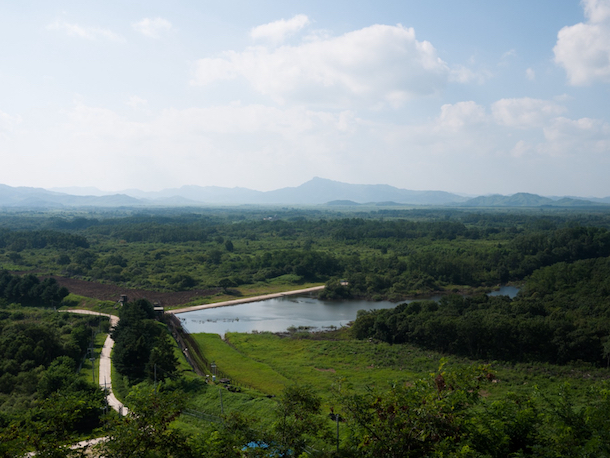
Every time I toe the border, I’m struck by contrasts. My homeland is a place of contradictions. There are consequences. There is pain.
When a body is divided, it bleeds. The pain is real, even if many of us are unable to recognize it day to day. It comes from the collective wound that is the division.
In North Korea, the pain is less abstract. The abundance of difficulties and scarcity must be powerful reminders. There are signs everywhere calling for reunification. People sing songs about it. It is a common topic of conversation.
In the South, the people who feel this pain most explicitly, who have immediate familial ties to the North, are dying. But the pain remains, however unremarked by those of us who are diasporic or too young.
Ever-present and deep-rooted, the pain masquerades as a part of normal life. It manifests itself in part through plastic surgery, over-consumption, classism, decadence, self-erasure, smallness.
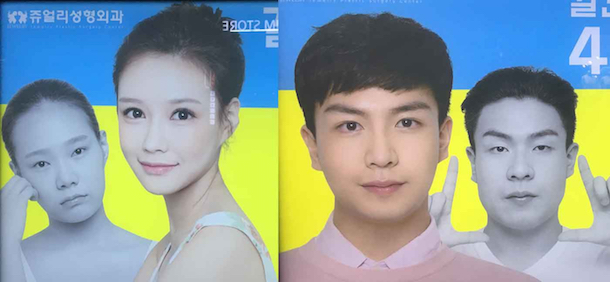
The pain of division is like an omnipresent noise that we can’t hear because we’ve never known its absence. When it’s gone, the silence will be deafening. That silence will show us the true face of what was there before, bringing into relief a roar in which we have been living, thinking it’s how things should be.
One day, when my country is whole again, when the noise is gone, we can begin to hear, and we can begin to heal.
***
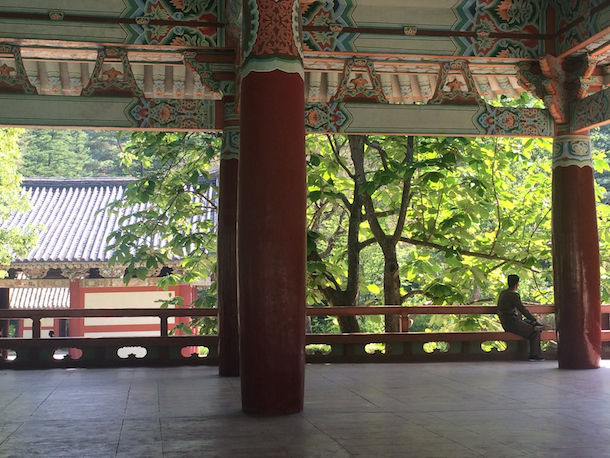
“Comrade, what is wrong?”
My face is still in my hands. To my dismay I hear more minders approaching, footsteps on dry gravel, whispering among themselves.
통곡하고 있어요. She is weeping.
I feel a hand on my shoulder. “Did we do something? Did someone say something to offend you? Did someone hurt your feelings?”
I reply through my hands:
아니요. No.
My voice is thick.
“What is it? What has happened? Why are you crying? Tell me.” She is increasingly alarmed. Please don’t cry, comrade. If you continue, I will be sad too. The warmth in her voice only makes it worse.
When I say, in between,
왜, Why,
she draws back slowly.
She is a delegate’s minder. She must be in her late twenties or early thirties. Her face is round and pleasant. There is a calmness about her. She wears a watch with a metal band on her left wrist and sports a stylish hair cut. Her dialect is lilting. We had never spoken before.
She says, finally:
압니다. I understand.
Her voice, too, has become thick. She puts an arm around me. She doesn’t say anything more.
We stand there until I can take my hands away from my face. I make an attempt at a joke and she laughs. She takes out some tissues. We dab at our faces, then walk forward silently to rejoin the group.
***
We are at the precipice of war. This is an evergreen statement when it comes to Korea, but today in 2017, the danger feels inordinately close. Much is in the hands of unworthy men, and I think about my friend. It has been over two years. I sent a paper letter with some photographs once, via a peace maker and then an intermediary in the North Korean government. I don’t know if she has received it. It’s not clear how safe it is to bring attention to her in that way. So I don’t send anything any more.
***
On the 24th of May, 2015, before we cross the DMZ, we say goodbye at the border. The minders wear traditional apparel in solemn colors. White above, dark below. We embrace.
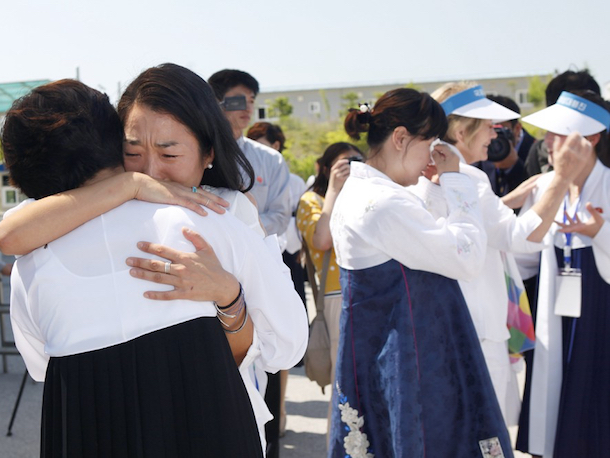
There’s anxiety as the delegates continue on to the second part of the peace mission, in Seoul. We are seen by far-right activists and Korean neo-conservatives led by Park Geun-Hye as naïve; shills and accomplices to a brutal regime and their human rights violations. The myopia and hatred are staggering.
To distract from news of protests and police anticipating our arrival in South Korea, I ask her what she will do the rest of the day. She looks down.
“Wait for news of your safe return.”
I stand there thinking of how to respond. Finally I take hold of her hand and say:
또 봐요.
“I’ll see you soon.”
